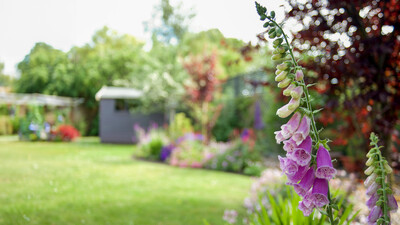A beautifully kept lawn is often seen as the jewel of a British garden. But all it takes is one heavy downpour to reveal the hidden truth beneath the surface. If water is pooling on your lawn, turning the turf spongy underfoot, or causing yellowing patches to spread across the grass, the issue is clear: your lawn has a drainage problem. And while a bit of mud might not seem like a crisis, the consequences of poor drainage can be far more damaging – both to your garden’s appearance and its long-term health.
Whether you’re dealing with persistent puddles, saturated soil, or mysterious soggy corners that never seem to dry out, sorting your garden drainage could be the single most important step you take in protecting your outdoor space. Let’s look at why it matters, how to identify the problem, and what solutions will work best depending on your lawn and layout.
Why lawn drainage matters more than you might think
A poorly drained lawn isn’t just an annoyance when you’re trying to mow the grass or set up a garden table. Over time, excessive water in the soil disrupts the healthy balance of air and nutrients needed for grass roots to thrive. Instead of flourishing, the lawn begins to suffocate – literally. Waterlogged conditions often lead to root rot, fungal infections and patches of dead or dying turf. The lush green is replaced by yellowing blades and muddy ruts.
Compacted soil becomes another knock-on problem, as heavy footfall or machinery compresses wet ground and reduces the space available for oxygenation, drainage and root development. In these conditions, moss and algae quickly gain a foothold, spreading across your once-healthy lawn and creating an unsightly, slippery mess. Even worse, excess surface water can make its way toward paths, patios, or your home’s foundations, potentially leading to long-term structural damage. In short, ignoring lawn drainage is rarely a good idea.
Recognising the warning signs of a poorly drained lawn
While the occasional puddle after a downpour is usually nothing to worry about, there are several red flags that suggest your lawn’s natural drainage is struggling to cope. Persistent water pooling, particularly in the same locations time and again, is often the first clue. If your boots squelch every time you cross the grass – even after a few dry days – it’s a strong sign that the ground beneath the surface isn’t draining properly.
Other signs include uneven grass growth, with some areas appearing lush while others thin out or turn brown. You might notice a faint musty smell, especially in warm weather, which is often the result of standing water and anaerobic conditions below the surface. And if moss begins spreading across the lawn, particularly in shaded or low-lying areas, this is often the lawn’s way of telling you it’s had enough of being wet for too long.
Choosing the right drainage system for your lawn
Once you’ve confirmed that drainage is the issue, the next step is choosing the right system to fix it. The best solution will depend on your garden’s layout, soil type, and how severe the problem is. Most domestic lawn drainage systems fall into one of two broad categories: French drains and soakaways.
French Drains and Their Layout Variations
A French drain is essentially a gravel-filled trench containing a perforated pipe, designed to collect and redirect water. What changes is the way the pipes are arranged beneath the lawn. These layout variations affect how efficiently the system collects water, depending on your garden’s shape and drainage pattern.
Linear
The most basic configuration, ideal for guiding water away from a single problem area. This is common on sloped lawns where water naturally flows in one direction.
Herringbone
One of the most effective and widely used configurations, especially for large, flat lawns. A central trench runs the length of the lawn, with shorter diagonal trenches feeding into it from either side, forming a pattern that resembles a fish skeleton. This collects water across a wider area and channels it into a single outlet.
Grid or Interceptor
Suited to very large or irregular spaces, this configuration features trenches laid out in a grid formation, ensuring comprehensive drainage coverage. This is more labour-intensive but effective when water problems are spread across the entire lawn.
Finger Drain
Multiple parallel trenches, like fingers, branch off a central collection point with this configuration. It is best for targeting specific waterlogged sections while keeping disruption to a minimum.
Each of these layouts uses the same basic components – trench, gravel, pipe and membrane – but must be tailored to the specific drainage behaviour of your lawn.
Soakaway Systems
Unlike French drains, which move water away from problem areas, soakaway systems are designed to temporarily hold water underground and let it gradually infiltrate the surrounding soil. They are particularly useful where there’s no easy runoff point – for example, on flat lawns with clay-heavy soils.
Soakaways are usually built using modular crates or pre-formed chambers, surrounded by gravel and wrapped in a geotextile membrane. Drainfast’s 20-tonne soakaway crates are ideal for garden use and are lightweight, stackable and easy to install. These systems are often used in combination with French drains, allowing you to collect and disperse water in one continuous system.
Products that make a difference
To install any of these systems effectively, it’s crucial to choose the right materials – and that’s where Drainfast can help. Their product range includes everything needed to install a robust and long-lasting lawn drainage system, from high-quality land drain coils to soakaway crates and geotextile membranes.
For example, their 100mm perforated land drain coil pipe is ideal for French drains and other trench-based systems. Flexible and durable, it’s easy to work with and allows water to enter from all sides.
If a soakaway is needed, their heavy-duty modular crates provide the perfect solution, allowing for fast installation and effective water storage.
Don’t overlook the importance of a proper geotextile membrane either. This fabric sits beneath and around your drainage elements to prevent soil from clogging the system over time. Drainfast’s non-woven geotextile membrane is highly rated by drainage experts.
Can a land drain be connected to a watercourse or storm drain?
In many domestic lawn drainage projects, the goal is simply to disperse water within the property – either into a soakaway or to a less-used or better-drained area of the garden. But in cases where a lawn consistently collects large volumes of water, or when drainage needs to be more engineered (for example, on clay soils or in high-rainfall areas), it may be tempting to connect land drains to a nearby ditch, stream, or local stormwater system.
While technically possible, doing so comes with significant practical and legal considerations.
Regulatory Issues
In the UK, any direct discharge of water from a land drainage system into a watercourse, ditch, or storm drain is regulated. You may need:
- Consent to discharge from the Environment Agency (EA) in England or the relevant authority in Scotland, Wales or Northern Ireland
- Land drainage consent if the outfall enters a main river or ordinary watercourse
- Permission from the local council or water utility if the discharge goes into a public sewer or stormwater drain.
These permissions are not just a formality. Unauthorised connections can lead to fines or enforcement orders – particularly if the discharge carries silt, fertiliser run-off, or other contaminants into sensitive water bodies.
Practical Considerations
Even if consent is granted, you must still manage:
Elevation and fall
The land drain must slope consistently to allow gravity-fed flow to the outfall. A poorly calculated gradient can cause standing water or backflow.
Filtration
Before discharging, water may need to pass through a filter chamber or silt trap to avoid blockages and pollution downstream.
Backflow prevention
Storm drains can occasionally back up. Installing a one-way valve (non-return valve) protects your system from floodwater re-entering the garden.
For domestic gardens, using a soakaway is often simpler, avoids red tape, and still provides effective drainage – provided your soil is suitable and the water table is not too high.
What to expect during installation
The process of installing a lawn drainage system varies depending on the chosen method, but the general principle remains the same: collect the water, redirect it, and let it safely disperse. First, you’ll need to assess the landscape, identify the worst-affected areas, and plan the layout of your system, making sure to work with the natural flow of water wherever possible.
Trenches or pits are then dug to the appropriate depth and width. For pipe-based systems like French or herringbone drains, this usually means a trench around 300–500mm deep. A geotextile membrane is laid down, followed by a layer of gravel. The perforated pipe is then placed in the trench, covered with more gravel, and the membrane folded over before the trench is backfilled with soil and re-turfed.
Soakaways require a wider, deeper excavation to house the crate system, but follow similar principles in terms of lining, filling, and backfilling. In all cases, care must be taken to avoid damaging underground utilities or creating uneven ground that may lead to further issues later.
Can you do it yourself?
This is a question many homeowners wrestle with. If your lawn is small, the issue is localised, and you’re confident using a spade, spirit level and shovel, then there’s no reason you can’t take on a drainage installation as a DIY project – especially with the wide availability of easy-fit components and online guidance.
However, if the lawn is large, the drainage issue is severe, or your garden contains slopes, trees, hard landscaping or restricted access, calling in the professionals is often the safer route. Not only can they ensure the job is done correctly, but they’ll also help you comply with any relevant building or water management regulations that may apply to more extensive work.
What if the problem persists?
Even the best drainage systems can run into trouble. Over time, blockages can form in pipes due to sediment or root ingress. Soakaways may become clogged if they’re not properly wrapped in geotextile, or if the surrounding soil is too dense to allow water to percolate. Surface pooling may return if soil becomes compacted above the drain, or if the system was incorrectly laid in the first place.
If your installed system seems to be failing, it’s worth inspecting each component carefully. Clear out any blockages, check that the system has a sufficient gradient, and make sure the water has somewhere to go. Drainfast supplies a range of fittings and accessories that can help with upgrades or repairs, and our customer service team is available to offer advice when needed.
Take control of your lawn’s future
Addressing a lawn drainage issue might not be the most glamorous garden project, but it’s one of the most impactful. By choosing the right system, using quality components, and installing it with care, you can transform a soggy, frustrating outdoor space into a vibrant, usable lawn that stays healthy year after year – no matter how much rain falls.
To explore our complete range of lawn drainage products and get started on your project, visit our website www.drainfast.co.uk or call us on 01420 555600 for expert, friendly advice.

Written by
Vicki James
Sales & Marketing Coordinator
Vicki is a vital part of the marketing team; from reporting to copywriting, she ensures we complete projects on time.

